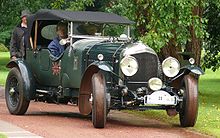Bentley 4½ liter
The Bentley 4 ½ liter was a car model from the manufacturer Bentley . The vehicles arose from the chassis and body superstructures offered by Bentley between 1927 and 1931 by various wheelwright shops. From 1929, a more powerful model with a supercharger was also available, which became known as the Blower Bentley .
history
1927–1931 Bentley 4½ liter
The Bentley 4½ liter proved to be successful with victories on the most important racetracks . Among other things, the model won Le Mans in 1928 . The sales figures achieved were able to replace the lost quantities by stopping production of the 3 liter . The 4½ liter was also the first Bentley in which the production costs were kept tight by strictly limiting the number of chassis variants to two.
The sales figures for the 4½ liter were good - but ultimately this model also fell victim to the economic crisis. In 1929, 234 chassis were manufactured. In 1930 production fell to 79 units. In the last six months of 1931 it sank to 15 chassis. A total of 669 chassis were produced, including six chassis that Rolls-Royce made from spare parts in 1936/37.
1929–1931 Bentley 4½ liter Supercharged ("Blower")

Tim Birkin , like Woolf Barnato also a Bentley Boy , converted a 4 ½ liter on his own initiative and with the financial support of Dorothy Paget from January 1929 . The vehicle was equipped with a Roots supercharger and other modifications, and so modified to the Bentley 4½ liter Supercharged . Birkin built a total of five of the models known today as Birkin Blowers in his workshop, one of which, however, was not ready to drive.
Walter Owen Bentley was not convinced of the vehicle. In 1929 he wrote on the supercharged principle: "to supercharge a Bentley engine was to pervert its design and corrupt its performance", about the Paget-Birkin partnership that created the supercharged "the organization that gave us all a good deal of additional anxiety during our already anxious last months "and about Birkin:" His gaily vivid, restless personality seemed to be always driving him on to something new and spectacular, and unfortunately our 4 1/2-liter car was one of his targets. "
The "Blower" offered from April 1930 was a technical (oil pressure / lubrication, cooling, etc.) and financial disaster. The fuel consumption of the Blower was downright adventurous: The consumption of the 4½ liter at a speed of 100 km / h was 16 liters / 100 km, the Blower Bentley, on the other hand, needed 102 liters.
The technical disaster was followed by the financial one. To be registered in Le Mans, at least 50 vehicles of one type had to be produced. Barnato ordered the vehicles to be built - against WO Bentley's wishes. The company produced the individual parts for the required 50 vehicles and assembled them after receiving the order. However, the sale of these "stock items" was very slow due to the lack of racing success. So in January 1931 the price was lowered in order to stimulate sales, which was also successful. The original price of £ 1,475 was lowered to £ 1,150 in January 1931, only £ 100 more than a standard 4½ liter. In the six months of production in 1931, 27 chassis were sold.
Barnato won the Le Mans races in 1929 and 1930 in a Bentley Speed Six designed by WO Bentley . So he did not drive the blower he had ordered himself. In 1929 two 4½ liters were able to reach the finish line in second and third place. In 1930 two blowers were used, one of which even drove the fastest lap of the race. However, both blowers then failed due to technical defects.
A total of 55 chassis were produced, five of which (including one not ready for use) by Birkin, 49 by Bentley and another in 1933 by Rolls-Royce .
1936–1937: 4½ liter reconditioned
After Bentley was bought by the competitor Rolls-Royce in 1931, the inventory also changed hands. From 1933 Rolls-Royce produced the newly developed Bentley 3½ liter and 4¼ liter models , with which no parts from this inventory were compatible. In 1936/37 six Bentley 4½ liters were rebuilt as "RC-Series" from the spare parts that had been in stock for years, similar to the 3-liter model . However, they differed from the original factory version, because the gearboxes came from the inventory for the Bentley 4½ liter compressor . The rear axles came partly from the supercharged Bentley, partly from the Bentley 6 ½ liter . The front axles, however, were originally intended for the Bentley 4½ liter and for the 4 liter . The steering also came from the 4 liter . Including these six chassis, the total production of the Bentley 4½ liter amounts to 665 chassis. With the exception of a body from Corsica , all cars received four-seater bodies from Vanden Plas and were given to customers with a five-year guarantee.
literature
- Klaus-Josef Roßfeldt: Rolls-Royce and Bentley Automobile, From the beginning of the century to the new millennium. Self-published, 1998, ISBN 3-00-004434-5 .
Web links
Individual evidence
- ^ A b A history of the UK's part in the 24-hour race . classicandperformancecar.com. Archived from the original on November 13, 2010. Retrieved June 2, 2012.
- ↑ a b 1931 Bentley 4½ liter Supercharged Boattail . sportscarmarket.com. Archived from the original on April 15, 2012. Retrieved June 2, 2012.
- ↑ 1926–1930 Bentley Blower ( en ) TopSpeed.com. Retrieved March 5, 2011.
- ^ The Automotive history of Bentley. ( en ) Justgoodcars. Archived from the original on February 16, 2011. Retrieved March 5, 2011.
- ↑ Car of the Month - November 1999 Bentley 4½ liter Tourer . rrab.com. Retrieved June 2, 2012.



